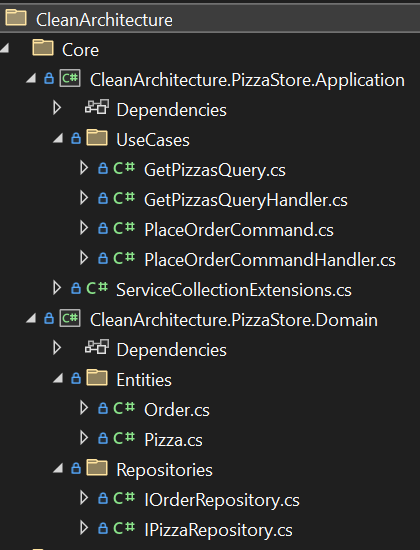In this article, we are going to discuss the differences between onion architecture and clean architecture in .NET. These patterns are often used interchangeably, and while they are very similar, there are some key differences that we will highlight.
First, let’s talk about the two architectures.
What Is Onion Architecture?
Onion architecture is a type of layered architecture that can be visualized as a series of concentric circles, resembling the layers of an onion. Jeffrey Palermo first introduced this architecture to address the shortcomings of the traditional N-layered architecture approach.
There are various ways to segment the onion architecture, but there are some common layers:
- Domain Layer
- Service Layer
- Infrastructure Layer
- Presentation Layer
Conceptually, the infrastructure and presentation layers are considered to be at the same level in the hierarchy.
Let’s consider the hierarchy:
Notably, the outermost layers only depend on the inner layers, not the other way around. As we gradually ‘peel the layers of the onion,’ we expose the inner layers.
It’s worth noting here that this pattern is sometimes referred to as the “Hexagonal Architecture” or “Ports and Adapters Architecture”. In these architectures, the core of the application, or the “hexagon,” is surrounded by “ports” that is, defining the interfaces through which the application interacts with the outside world.
“Adapters” are responsible for implementing these interfaces and connecting the application to external systems or frameworks. However the principles are essentially the same, so from here on out we’ll be focusing on onion.
Next, let’s look at the clean architecture pattern.
What Is Clean Architecture?
Clean architecture is a pattern focused on creating applications that are easy to maintain, as well as scale and test. Similar to the onion architecture, we achieve this by dividing things into layers with specific roles.
Let’s discuss the layers:
The domain layer, identical to the onion architecture layer, represents the core business rules and entities. In essence, it should not rely on other layers.
The application layer, positioned just outside the domain layer, acts as an intermediary, containing the use cases that expose the business rules. It only depends on the domain.
The infrastructure layer, again identical to the onion architecture, implements external services such as databases, file storage, and emails. It contains the implementations of interfaces defined in the domain layer.
The presentation layer, once again similar to the onion architecture, is responsible for handling user interactions and displaying data to the user interface.
A key principle here is that the dependencies flow inwards. This allows specific implementations to be changed in the future without impacting other parts of the application.
Differences Between Onion and Clean Architecture
So far, things are looking very similar between the two architectural patterns. People often use the topics interchangeably for this reason.
First, let’s highlight the dependencies that each project depends on, in the two different architectures, starting with Onion Architecture:
| Layer | Project | Depends On |
|---|---|---|
| Presentation | API | Everything |
| Infrastructure | Persistence | Domain |
| Core | Services.Abstractions | Contracts, Domain |
| Services | Contracts, Domain, Services.Abstractions | |
| Contracts | Domain | |
| Domain | N/A |
Now, let’s look at the dependencies in Clean Architecture:
| Layer | Project | Depends On |
|---|---|---|
| Presentation | API | Everything |
| Infrastructure | Infrastructure | Domain |
| Persistence | Domain | |
| Core | Application | Domain |
| Domain | N/A |
Although our applications have a different number of projects, the principles have remained the same. Core layer projects only rely on each other (e.g. within the same layer). Infrastructure layer projects only rely on the domain layer while the presentation layer projects rely on all other layers.
So in terms of dependencies, there is no difference in the patterns. The outermost layer depends on the inner layers. This is the core principle behind both patterns: dependency inversion. Read more about this principle in our article SOLID Principles in C# – Dependency Inversion Principle.
Let’s take a deeper look into the “Core” layers in each, to try and analyze the logical architecture and project structure.
Core Layer of Onion and Clean Architectures
In the onion architecture, our core layer is organized with a set of projects:
We have our domain or business entities, our exceptions, our repository interfaces, and our service interfaces/implementations. Additionally, these components are integral to the architecture. Notice everything is generic around “Pizza” and “Orders”.
Let’s look at our core layer in the clean architecture solution:
So we have entities again, and repository interfaces again. Nothing new there. But notice the CleanArchitecture.PizzaStore.Application project. It contains specific use cases, that we want the application to fulfill.
This is where one of the key differences in the patterns emerges. The clean architecture pattern attempts to organize code around use cases and has a real focus on business logic. The emphasis is placed on explicitly defining these use cases.
In other words, while the onion architecture focuses on the layers and the flow of dependencies, clean architecture focuses on organizing the application around use cases, whilst still maintaining the same dependency principles.
Perspectives of Onion and Clean Architecture
The differences between the two architectures are so negligible they require perspective. Let’s try to summarise it with some of those perspectives:
| Perspective | Onion Architecture | Clean Architecture |
|---|---|---|
| Focus | Emphasizes the central domain layer, and the layers around it. The focus is on maintenance and separation of concerns. | Focused on making the business logic independent from external layers. Emphasis is on flexibility and testability. |
| Structure | Layered approach, centered around domain model. Clear layers. | Concentric circles, layers focused on responsibility (e.g use cases, entities, adapters) |
| Flexibility | Separation of concerns focused on layering around the domain model. | Explicit guidelines for ensuring independence from frameworks and databases |
Clean architecture prioritizes business rule independence through a concentric layering of entities, use cases, and adapters, while onion architecture revolves around a central domain model with layers structured around it to maintain a clear separation of concerns and facilitate flexible dependency management.
How to Decide Which Pattern to Use?
Because the patterns are so similar, it’s hard to choose one.
Let’s look at a few considerations.
Structure & Flexibility
Like any architectural pattern, we are often trading off simplicity. So only use one of these patterns if we believe the application will grow with business needs and resources. However, between the two patterns, if the priority is complex business logic and decoupling from external frameworks and dependencies, clean architecture is the best choice. If the priority is around clear structure and layers, onion might be a better choice.
Skill
Because clean architecture strictly adheres to its guidelines, it might suit teams accustomed to such rules. This structure helps new developers integrate easily and reduces the chances of breaking established patterns. However, this adherence comes at the cost of flexibility. For experienced teams that understand and can maintain the focus on layers but prefer more flexibility, the onion architecture may be a better choice.
Maintenance
Clean architecture makes it easy to keep different business areas separate and extend them by explicitly exposing functionality through use cases, much like vertical slice architecture. On the other hand, onion architecture provides a clearer separation of concerns, which means it’s easier to extend the overall application.
Conclusion
In this article, we took a closer look at the onion and clean architecture patterns. Specifically, we examined their respective approaches to software design. Although very similar, we highlighted some nuances that can help us decide which one to choose when building our next application. Like with any architectural decision, it’s important to understand all the trade-offs as well as the reason behind applying the pattern. Hopefully, this article has helped to make that decision in the future.
Happy coding!








